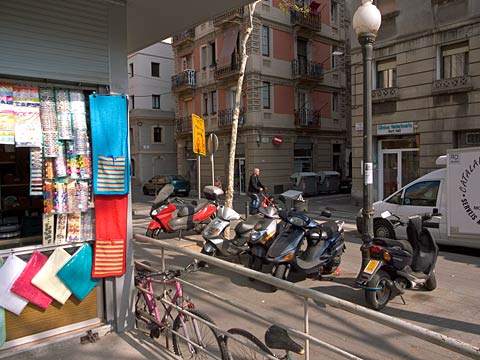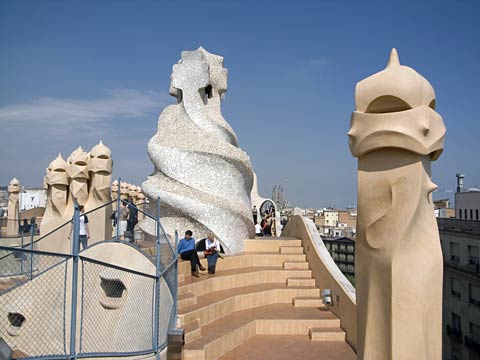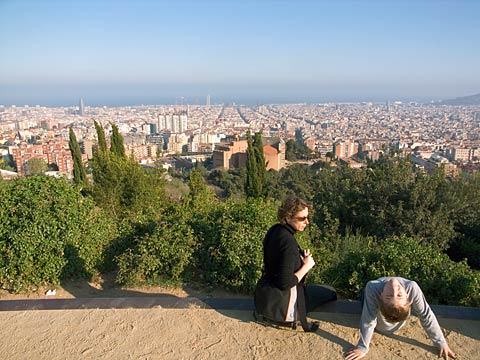Barcelona/Amsterdam

Barceloneta
My first visit to Barcelona, I was suitably impressed with the vitality and beauty of the city, both in its old and new aspects. Traveling with my wife and son, I stayed at the Casa Camper, a boutique hotel located conveniently between the Ramblas--the famous boulevard through the old city--and the modern museum designed by Richard Meier. The hotel, operated by the shoe brand Camper, served as a comfortable home base with excellent breakfasts, round the clock snack bar/lounge, and friendly staff. We were only in Barcelona two days, which is too little time for any city, but we spent our time well, walking and looking.
On the first day we walked down the Ramblas, through the seaside neighborhood of Barceloneta, and back through the Barri Gotic where we ducked into old churches and covered markets including the newly completed Santa Caterina Market by the late architect Enric Miralles. The colorful undulating tiled roof echoes the designs of Gaudi, Barcelona's famed architectural master. Dinner was at Comerç 24, a tapas restaurant featuring cutting edge Catalan cooking.
The second day was devoted largely to seeing the work of Gaudi. Closest to our hotel was the Casa Batlló, which to my eye is Gaudi's most recognizably art nouveau building. Many of his other projects push beyond the organic forms of art nouveau into the surreal and fantastical, and can only be described as uniquely Gaudi. A short walk up the street is the Casa Mila, an apartment building of surpassing urbanity and beauty, a miracle of architecture and craft. The facade of the Casa Mila is more refined and simplified than the Casa Batlló and expresses the fully realized structural inegrity of the building. The tour of the Casa Mila takes one through the entry courtyards, up to an apartment beautifully outfitted with period furniture, into an exhibition of Gaudi's work in the attic, and finally up to the roof with its strange anthropomorphic sentinels.

Case Mila
To the east we walked to Gaudi's last work and focus of his Catholic faith, the unfinished cathedral, Sagrada Familia. The towers of the church have become Barcelona's most notable icon, and for the first time in our visit to the city we encountered hordes of tourists emerging from double decker buses. The construction of the east facade was overseen by Gaudi before his death in 1926, but most of the newer postwar construction is an unfortunate bastardized interpretation of the Gaudi style. In the interior of the cathedral immense tree-like columns stand among a forest of scaffolding. The building will not be finished for decades, and one wonders whether it would not be better left as a ruin. The east facade with its depiction of the nativity is amazing to gaze upon, but overall the cathedral is monstrous and overbearing. Is this the culmination of Gaudi's spiritual quest?

Park Güell, Renée and Brendan
From there we took the subway to the Park Güell rising up above the city. Like the cathedral down below, the park was overrun with tourists, Americans to be sure, but mostly young Europeans. They sprawled out on Gaudi's endless mosaic bench, so many people that there was scarcely room for our party of three to find a place. Unlike the heaviness of the Sagrada Familia, Park Güell is Gaudi at his most fantastical and whimsical. We climbed the hill for a panoramic view of the city with the new Agbar Tower by Jean Nouvel poking up to the left of the Sagrada Familia. From there we joined the weary throng straggling down the hill to the tour bus stop or subway. We managed to snag a free taxi and retreated to our hotel. We returned to Amsterdam the following morning.

0 Comments:
Post a Comment
Links to this post:
Create a Link
<< Home